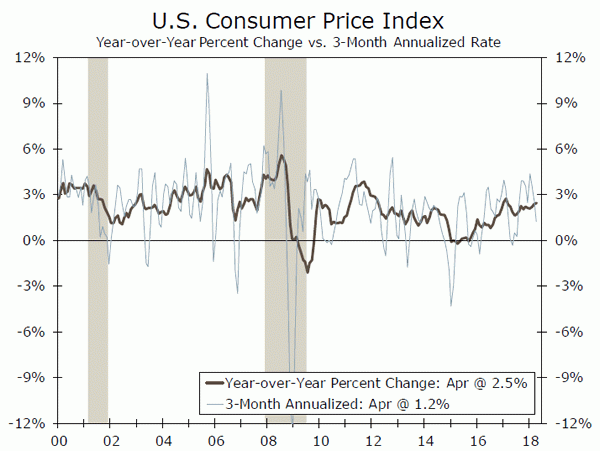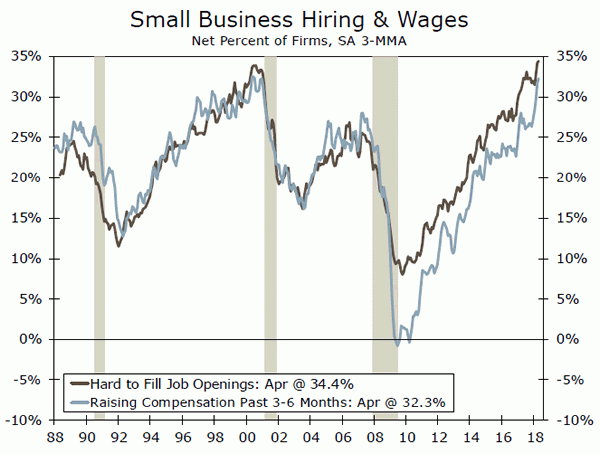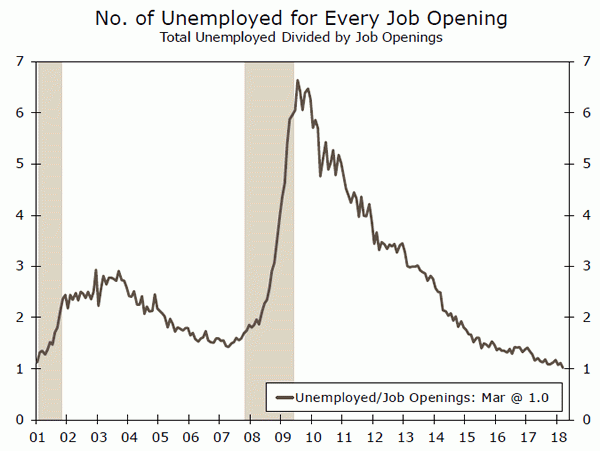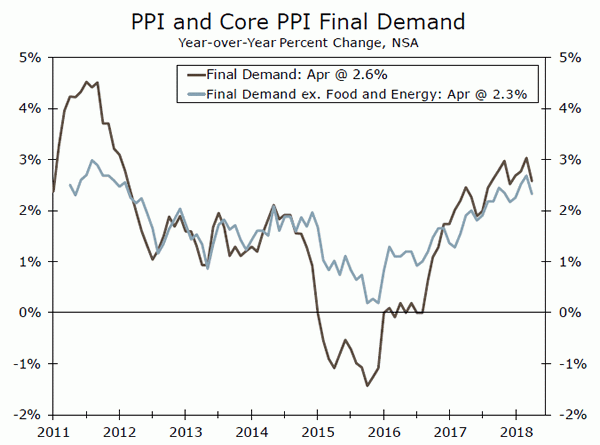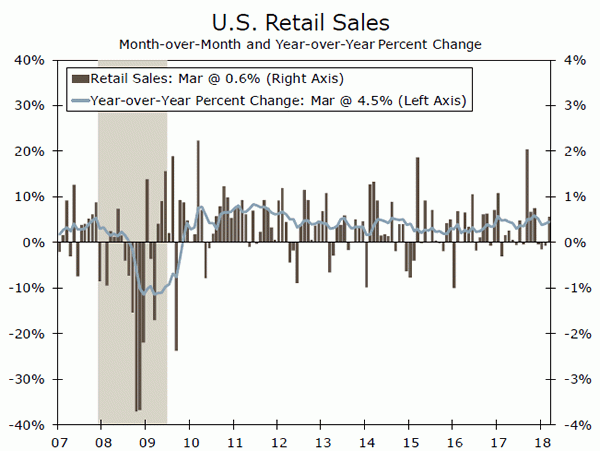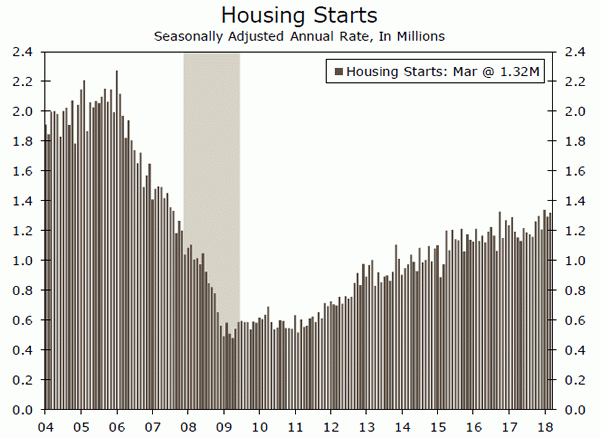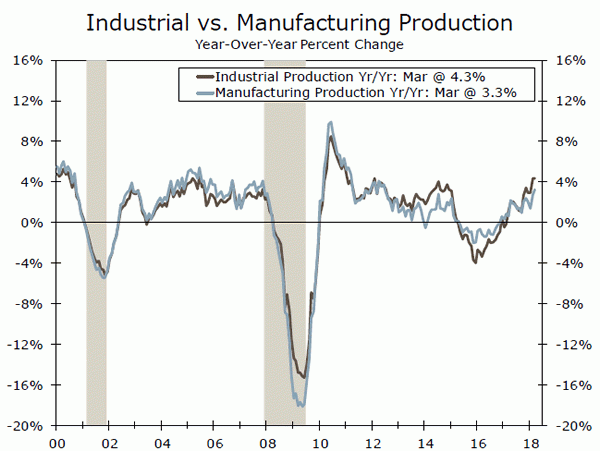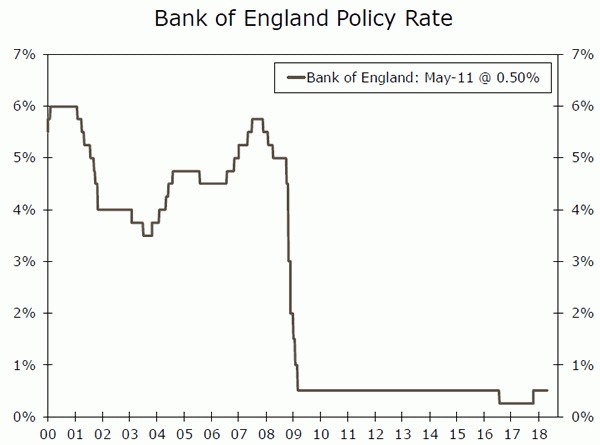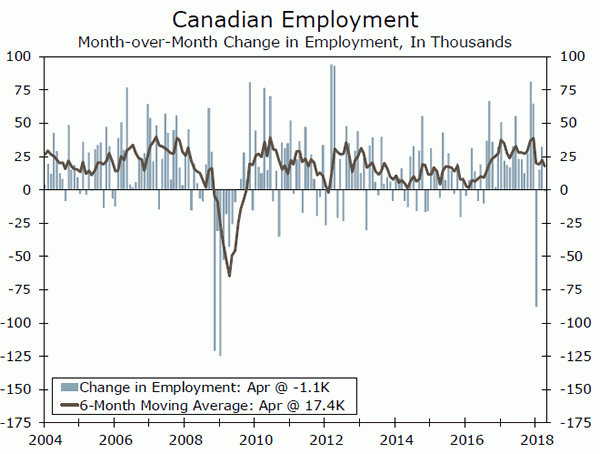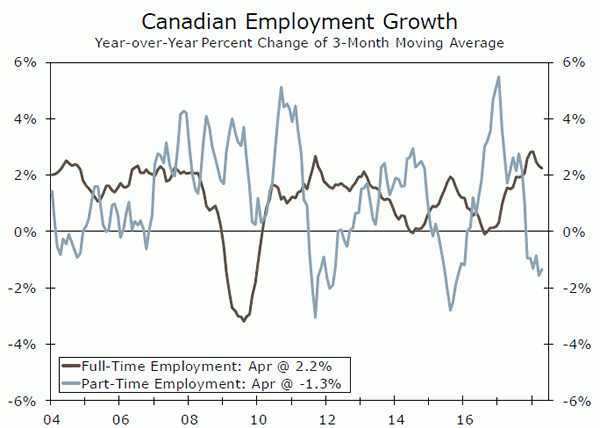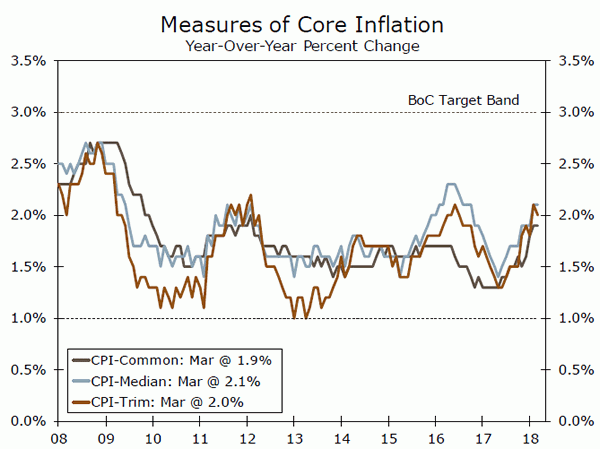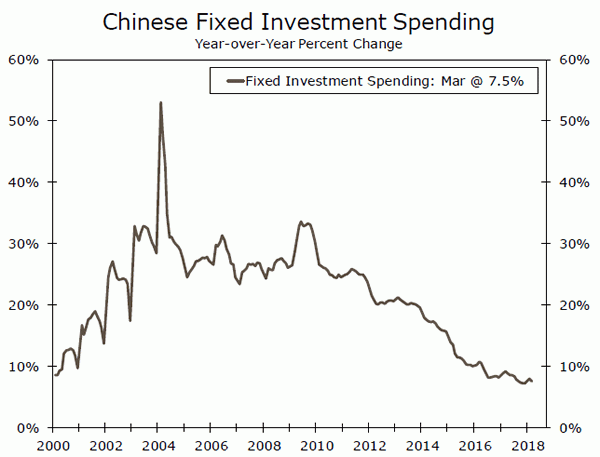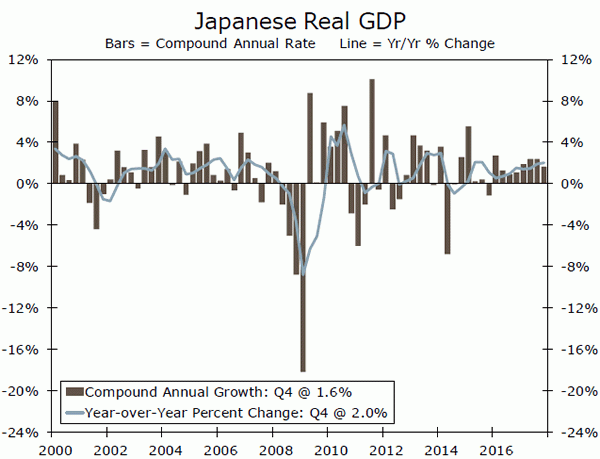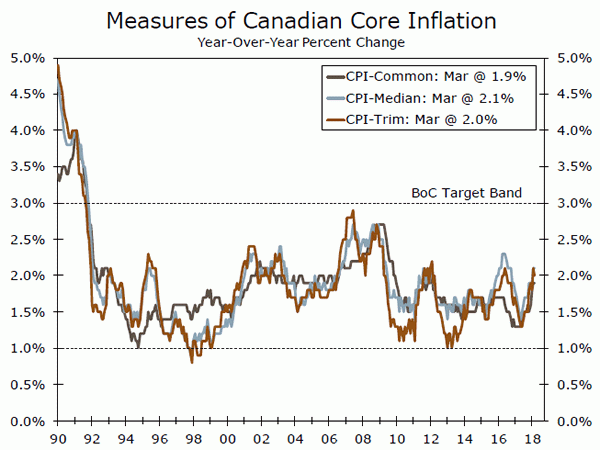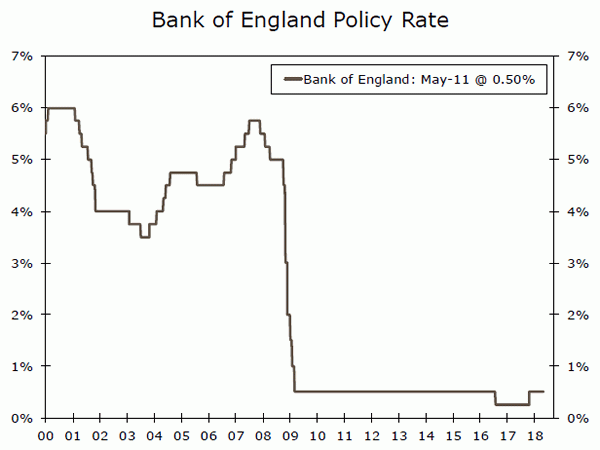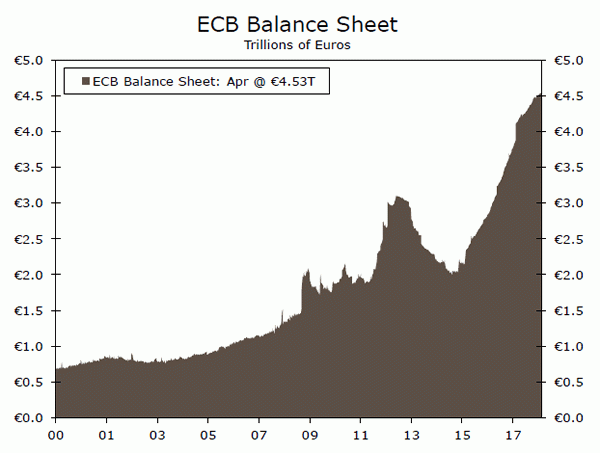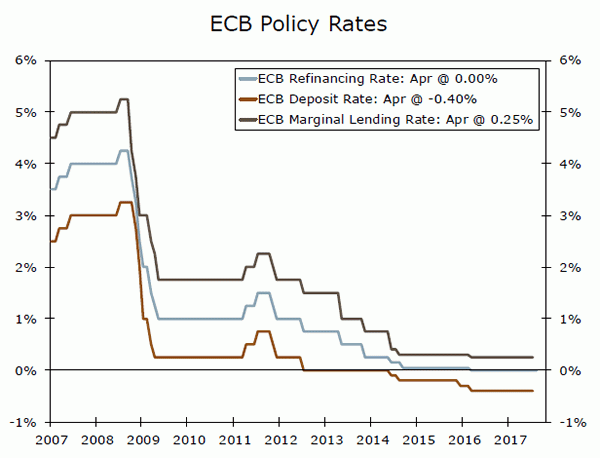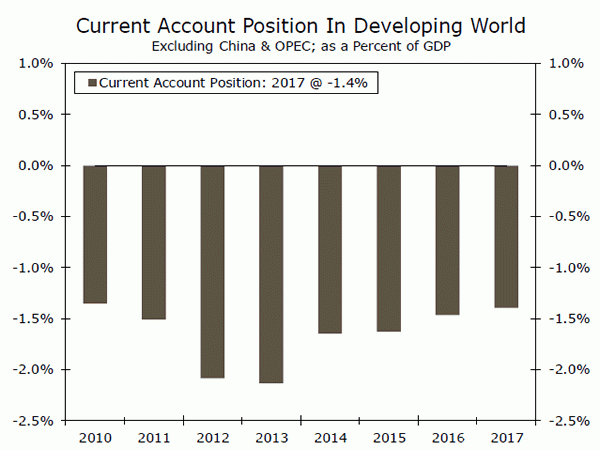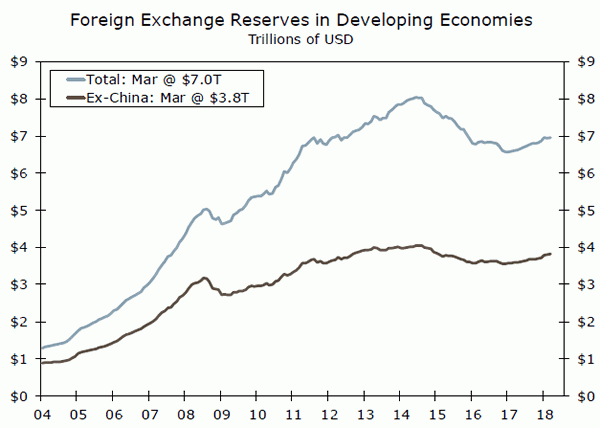U.S. Review
Inflation Readings Support Increasing Interest Rates
- Data released this week shed light on price pressures building in the U.S. economy. On the whole, it is clear that inflation is moving upward but is not yet unwieldy, which clears the way for the Fed to gradually raise rates this year. We expect three more rate hikes will be necessary by the end of 2018, with the next one in June.
- The tight labor market is increasingly pushing up wages, according to the NFIB. There was only one unemployed person per job opening in March. Firms are paying more for labor, and prices for other inputs are also increasing.
Price Pressures Rising at Manageable Pace
The economic calendar largely focused on inflation this week, with the release of the PPI, the CPI and import prices. Reports from the NFIB reiterated that small business is booming and main street is seeing more pricing power while raising compensation in an ever tightening labor market. Indeed, the Bureau of Labor Statistics (BLS) reported showed there was just one unemployed person for each open position in March.
Small business optimism rose slightly in April after losing some ground in March. That followed a cycle high hit in February after the tax cuts boosted the mood on main street. The mood is still very upbeat. Strong demand is translating into rising earnings on net for firms. Small businesses are also seeing greater ability to increase prices, with the measure of price increases rising to a cycle high in March and easing to its second-highest point of the cycle in April. It’s good that small businesses are finding it easier to increase prices, because tough competition for workers is pushing up wages. Hiring quality workers has become a top concern for small businesses, and the share of small businesses unable to fill open positions is at its cycle high. One-third of small businesses reported raising compensation, the highest since 2000. Optimism about earnings trends and tax policy changes are also likely contributing to the larger share of small businesses giving raises.
With one unemployed person per job opening in March, higher wages and the resulting inflation pressure is likely to continue. The job openings rate rose to a record high in March, reinforcing other indications of strong labor demand in the economy. Employees are taking notice. March marked the highest number of quits since 2000. Quits typically signal confidence in the labor market and usually result in a pay increase, which bodes well for wage growth.
The producer price index (PPI) rose 0.1 percent in April and moderated on a year-over-year basis to 2.6 percent. There were temperate gains across input categories, which show that while inflation is strengthening, it remains orderly. Core PPI also moderated on a year-ago basis but remains on an upward trend relative to this time last year. As an indicator for “upstream” inflation pressures, the PPI points to price increases down the line.
The consumer price index (CPI) came in softer than expected in April. Headline CPI rose 0.2 percent during the month while core CPI rose by a more tepid 0.1 percent. The trend remains upward on a year-ago basis, with the CPI rising 2.5 percent over the year while the core CPI rose 2.1 percent. The recent increase in energy prices was apparent with a 1.4 percent increase in the energy index in April. An increase in food prices also helped push the headline higher. The softer read on core CPI follows a ramp up in Q1, which had some worried that the Fed would need to tighten policy faster than was priced into the market. That April showed a more muted but still clearly increasing trend suggests Q1 strength may have been overstated. We expect the softer reading in April will not deter the Fed from raising rates another three times this year. FOMC meeting minutes and speeches by Fed presidents suggest that FOMC members are inclined to keep to a gradual approach to policy normalization. Measured reaction by the committee to last year’s inflation soft patch is further evidence of a gradual approach.
U.S. Outlook
Retail Sales • Tuesday
Retail sales reversed a three-month string of declines in March and increased 0.6 percent. Much of the improvement was driven by strong motor vehicles & parts dealers’ sales, which increased 2.0 percent for the month. Retail sales excluding autos grew 0.2 percent, with modest strength in health & personal care, nonstore retailer, and furniture & home furnishings sales. Meanwhile, the weakest sectors of the report were sporting goods, hobby, book & music and building material & garden equipment sales, both of which declined for the month.
Control group sales, which are used to calculate GDP, were strong at 0.4 percent in March and helped bolster first quarter consumer spending, which grew at just a 1.1 percent annualized rate. Despite rising inflation and a somewhat weak start to the year, we remain optimistic on the consumer and expect a bounce-back in Q2.
Previous: 0.6% Wells Fargo: 0.3% Consensus: 0.4% (Month-over-Month)
Housing Starts • Wednesday
Housing starts increased 1.9 percent to a 1.32 million pace in March. Multifamily starts accounted for most of the gain surging 14.4 percent during the month, while single family starts dropped 3.7 percent. Overall, starts through the first three months of 2018 are running 8.0 percent ahead of the same period one year ago.
Residential construction has been booming in the West, growing 34.2 percent in Q1 compared to last year. Meanwhile, a decline in single family units pulled down starts in the South for the month, bringing overall activity in the first quarter below the year-ago pace. The unseasonable weather was again apparent in the Northeast and Midwest, where single family starts declined through March.
Significant upward revisions to prior month’s data showed that residential construction had a much stronger start to the year than had been previously indicated. We expect activity to continue to build momentum and trend higher as the weather warms.
Previous: 1,319K Wells Fargo: 1,330K Consensus: 1,325K
Industrial Production • Wednesday
Industrial production beat expectations and expanded 0.5 percent in March, bringing a 4.5 percent annualized increase for the first quarter. Over half of March’s gain occurred from a rebound in utilities output, driven by increased heating needs due to unseasonably cold temperatures in the Northeast and South. Mining output continued to recover alongside rising oil prices and grew 1.0 percent. Meanwhile, manufacturing output stalled after February’s substantial gain, increasing a modest 0.1 percent for the month.
Overall, the factory sector appears in good shape. Manufacturing output only registered a modest improvement in March, however the slight gain followed the largest monthly gain since the end of the recession. We anticipate growth in the sector to continue, as core capital goods orders have been solid and the ISM manufacturing survey also remains near cycle highs.
Previous: 0.5% Wells Fargo: 0.7% Consensus: 0.5% (Month-over-Month)
Global Review
BoE Holds & Reasons Not to Fear Soft Canadian Jobs
- The Bank of England kept its benchmark rate unchanged at 0.50 percent at its meeting this week. The vote was split 7-2 with the dissenting votes both favoring a hike. A soft print for GDP growth in Q1 took some urgency out of the BoE’s rate hike plans, though stronger growth in the coming quarters should eventually support further rate hikes from the BoE (see Interest Rate Watch).
- Canada had another disappointing print for the April jobs report. In this week’s Global Review we get into the details of the Canadian labor market and actually find signs of strength.
A Soft Patch for Canadian Job Market? Not Really.
2017 was a stand-out year for the Canadian economy and that was particularly evident in the labor market. Canadian employers added to payrolls by the most in 15 years. Over 400,000 net new jobs were added at an average pace of about 35,000 jobs per month. In the fourth quarter, hiring picked up to an average monthly gain of 57,900.
Since the start of 2018, the job market has been more hit-and-miss. There were net layoffs in January of 88,000, though the drop then was entirely a function of a decline in part-time work. February and March were better, but only marginally so, with a net pick-up of fewer than 50,000 jobs. This week, despite expectations for a modest increase, the jobs report for April showed a small 1,100 decline.
“We’d Like to Make You Full-Time”
Despite the apparent slowdown, we are not convinced that the downshift in job growth necessarily signals tougher times for the Canadian economy. While it is true that job growth has slowed and the unemployment rate has stalled at 5.8 percent, the recent weakness has been more evident in part-time work than it has for full-time.
Full-time jobs actually increased 28,800 in April. In fact, the average increase in full-time jobs in the first four months of 2018 is 26,700, roughly in-line with the 32,600 pace of 2017. The yearto- date decline of 41,400 jobs in Canada is entirely attributable to a 148,200 decline in part-time jobs at a time when employers have simultaneously added over 100,000 full-time jobs. It is increasingly the case that businesses in Canada are hiring full-time workers and cutting part-time staff.
Another reason why the stalling of overall job growth is not particularly worrisome is the fact that Canadians are getting paid more. Average hourly earnings hit $27.02 CAD in May. That is a 3.6 percent increase on a year-over-year basis, making it the fastest pace of earnings growth in almost six years. That is hardly the sort of wage dynamic you would expect to see in a stalling job market.
How Will the Bank of Canada Look at This?
There is no shortage of hand-wringing in financial markets about the jobs news; the Canadian dollar was off about four cents versus the U.S. dollar in the immediate wake of the employment report. On that basis, it appears that not everyone shares our admittedly sanguine assessment of the job market. The real question is what the Bank of Canada thinks about the labor market and the extent to which the recent acceleration in earnings growth will translate into higher inflation.
While we have concerns about elevated consumer debt levels and overheated home prices, Canada’s full year GDP growth was 3.0 percent in 2017 and economic conditions remain supportive for modestly higher inflation. Core measures of the CPI have edged higher but remain in the middle of the BoC’s target range. That ought to be supportive of another rate hike in the second half of the year in our view.
Global Outlook
Chinese Retail Sales • Monday
Chinese economic growth once again held steady at 6.8 percent year over year in Q1-2018, and next Monday will offer the first look at key data on how the second quarter started. April data on Chinese retail sales, industrial production and fixed investment are due to be reported. Retail sales rebounded strongly in Q1 after hitting a rough patch in Q4-2017, but investment spending and industrial production both decelerated in March.
If next week’s data show industrial production and/or investment spending decelerating further, this would be supportive of our call that Chinese economic growth will gradually slow this year as policymakers grapple with large debt burdens in some sectors of the economy. A pick-up in both consumption and investment, however, would be a preliminary sign that Chinese economic growth in Q2 will hold steady yet again around 6.8 percent.
Previous: 10.1% Consensus: 10.0% (Year-over-Year)
Japanese GDP • Tuesday
Japan’s economy has managed to successfully register the longest period of uninterrupted growth since the 1986 expansion. While a welcome development, the sequential growth rate slowed in Q4-2017, and the consensus forecast is for another deceleration in Q1-2018. A broad-based slowdown in growth in advanced economies and a generally stronger yen in Q1 may have weighed on Japanese export growth.
The Japanese consumer price index also prints next week (Thursday). Both headline and core inflation remain well short of 2 percent. This fact, coupled with economic growth that appears to have slowed in back-to-back quarters, puts little pressure on the Bank of Japan to begin tightening monetary policy anytime soon. At its core, an aging population and years of low inflation/deflation have weighed on potential growth and inflation expectations in Japan, and reversing these trends is a herculean task.
Previous: 1.6% Wells Fargo: 0.0% Consensus: -0.1% (Quarter-over-Quarter, SAAR)
Canadian CPI • Friday
Bank of Canada (BoC) policymakers have faced a bit of a dilemma of late. Torrid economic growth in H1-2017 gave way to monetary policy tightening, but real GDP growth promptly slowed in the second half of the year. Early signs are that this slowdown in growth continued into Q1-2018. On the inflation front, all three of the central bank’s preferred core price growth measures are hovering smack in the middle of the Bank of Canada’s 1-3 percent target band.
High household debt levels are an ominous threat to the Canadian economy, and NAFTA-related uncertainty continues to lurk in the background. With inflation under control and economic growth having come back down to Earth, we continue to hold the view that the Bank of Canada will hike its main policy rate just once more in 2018. A pick-up in inflation is one catalyst that could force the BoC’s hand and alter our view.
Previous: 2.3% (Year-Over-Year) Wells Fargo: 2.2%
Point of View
Interest Rate Watch
BoE and ECB on Hold Indefinitely?
The Monetary Policy Committee (MPC) of the Bank of England decided this week to keep its main policy rate unchanged at 0.50 percent (top chart). Up until a few weeks ago, it appeared that the MPC would hike rates 25 bps at this policy meeting. However, the weak GDP growth rate that was released on April 27—real GDP grew only 0.1 percent (not annualized) on a sequential basis in Q1—evidently made some MPC policymakers hesitant to hike rates at the present time.
The market now assigns a greater-thaneven chance that the MPC will be on hold for the rest of the year. We are not so sure, because we look for GDP growth to rebound in coming quarters. We acknowledge the downside risks that Brexit uncertainty imparts to the economic outlook, but we still forecast that the MPC will raise rates 25 bps at the August 2 policy meeting. After that rate hike, we then look for the MPC to remain on hold through the end of the year.
Across the English Channel, the Eurozone has also shown some signs of economic deceleration recently, but not to the same extent as in the United Kingdom. Although we do not look for growth to rise again to the rates that were registered at the end of last year—real GDP grew 2.8 percent in Q4 2017, the strongest year-over-year rate in more than six years—we forecast that growth will generally remain solid.
The Governing Council of the ECB left its policy unchanged at its last meeting, which was widely expected. The ECB has said that it intends to continue to purchase €30 billion worth of bonds through September. We then look for it to “taper” its purchases to €10 billion or €15 billion per month through the end of the year, before ceasing to buy bonds altogether.
The next question is the timing of potential rate hikes. We look for the ECB to raise its deposit rate from -0.40 percent to -0.20 percent about a year from now. We forecast that sometime next summer it will then take its deposit rate to 0.00 percent while also lifting its main refinancing rate to 0.10 percent. We look for that rate to end 2019 at 0.25 percent.
Credit Market Insights
Demand of C&I Loans Weakened
This week, the Federal Reserve released its senior loan officer survey for Q1. The survey examines lending practices and behaviors among domestic and foreign banks and reports customer demand for different types of loans. On net, domestic and foreign banks reported an easing of standards for commercial & industrial (C&I) loans. The respondents cited increased competition among other lenders as the primary reason why standards were lowered. Banks also pointed to a more favorable economic outlook and less uncertainly surrounding the recent legislative changes as reasons for loosening loan terms.
Despite the encouraging economic environment from lenders’ perspective, customers’ views appear to differ. A net percentage of banks reported that demand for C&I loans weakened in Q1. In fact, demand for all types of loans (credit cards, autos, CRE) have weakened on a four-quarter moving average. Moreover, banks overwhelmingly reported weaker demand for all types of residential mortgages even as lending standards are being relaxed. Rising short-term rates, which directly translate to higher mortgage rates, seem to be affecting customer demand. The clearly telegraphed timeline of the Fed regarding the shrinking of its balance sheet and plans to continue along its tightening path likely influenced potential home buyers and businesses to lock in low fixed rates ahead of all-but-certain higher rates in the near future.
Topic of the Week
Trouble Brewing in Developing Economies?
Argentina was in the news this week due to the recent free fall in its currency. (The peso, which is down about 10 percent against the U.S. dollar since late April, currently sits at an all-time low versus the greenback.) The country went to the IMF this week requesting financial assistance. The Turkish lira has also been pounded in recent weeks, and the currencies of many other developing economies have also softened vis-à-vis the dollar. Could another “taper tantrum” à la 2014-15, when prices of financial assets in most developing economies came under downward pressure due to expectations of eventual Fed tightening, be in the offing?
An environment of rising U.S. rates erodes the attractiveness, everything else equal, of riskier assets such as emerging market stocks and bonds. As long as the Fed is “in play,” prices of financial assets in developing economies could experience some downward pressure. But we would expect that any significant weakness would be largely confined to individual economies rather than to the entire asset class.
Argentina and Turkey have large current account deficits on the order of 5 percent or so of each country’s respective GDP. These deficits need to be financed via capital inflows from abroad, and these inflows can quickly dry up in an environment of rising U.S. rates and/or risk aversion. But the aggregate current account deficit in the developing world (excluding China and OPEC countries) has narrowed over the past few years (top chart). Therefore, developing economies in general are not quite as dependent on foreign capital inflows as they were just a few years ago. Furthermore, many developing economies have built up ample war chests of foreign exchange (FX) reserves over the past decade or so (bottom chart), and these FX reserves can be used to offset some of the downward pressure on those currencies. Although some developing economies could experience continued financial market volatility, we do not look for another generalized “taper tantrum.”




